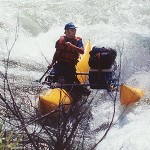Comments Reviews on theboatpeople.com Raft Cataraft Inflatable Kayak Products and Service › Forums › Comment on Products › Inflatable Kayaks Touring › INNOVA › INNOVA Safari Inflatable Kayak › Safari 330 initial impressions by Joel (customer)
- This topic has 0 replies, 1 voice, and was last updated 6 years, 8 months ago by
 Lee Arbach TBP.
Lee Arbach TBP.
-
AuthorPosts
-
August 6, 2018 at 9:56 pm #3181
 Lee Arbach TBPKeymaster
Lee Arbach TBPKeymasterTook the Safari out for the first time, a 45 minute, mid-morning paddle
in a protected, saltwater bay. Light wind, 64 degrees F, mostly flat
conditions. I’m a 60 year old, male paddler, 5’11”, 150 pounds. I’ve
paddled sea kayaks and surfskis for 30 years, and used to do a fair
amount of open-water racing.I purchased the Safari as an affordable, lightweight, fun, easy to
transport boat I could take out on saltwater, lake, and flatwater river
day trips; especially with less-fit paddlers in recreation type kayaks.
I also wanted a small boat for playing in surf. I didn’t want a PVC
boat, so opted for the Safari over the lighter Swing and Twist, because
of the more durable Nitrolon hull material, its self-bailing scuppers,
and open cockpit. This is my first inflatable kayak.On opening the box, I could tell this wasn’t your typical pool-toy
kayak. Gumotex (the Czech Republic manufacturer) has been making boats
for many years, and the quality of the material and construction is
immediately apparent.Inflation with a Bravo 7 foot pump was a breeze at a bit over 5 minutes.
The 3 PSI chambers provide a good amount of rigidity and I was
pleasantly surprised that with the tube width, the cockpit area wasn’t
too expansive.The kayak is easy to shoulder carry; finding the balance point is quick.
With the seat, foot rest, thigh straps, and skeg, the Safari weighed 27
pounds 6 ounces on my bathroom scale.The boat has rock solid, primary stability. Previous generations of the
Safari had a reputation for being tippy, not so with the longer and
wider 330 model. I wouldn’t hesitate to put a beginner in this boat. I
had the seat pad fully inflated; there was no need to deflate it to
lower my center of gravity. At my weight with no gear, I wasn’t
displacing much water; there’s definitely more hull exposed out of the
water compared to a hardshell or folding kayak. As there was minimal
wind, there was no way to get a feel for the impact of increased surface
area. Paddlers weighing over 200 pounds have mentioned getting their
bottoms wet in prior Safari models, but I noticed no water accumulation
inside the boat aside from paddle drips.I used a 220 cm European touring paddle with a high angle stroke and had
no trouble clearing the tubes. According to my GPS, I was able to cruise
at 3 to 3.5 MPH; using a high angle stroke. Low angle, more recreational
touring pace, was in the 2.5 to 3 MPH range. Hull speed seems to
somewhere between 4 MPH and 4.5 MPH.With the skeg, the boat tracks remarkably well for being so short. It is
very responsive and turns on a dime, even with the skeg installed.The inflatable seat has a low back that is perfect for a proper,
torso-engaged forward stroke; the inflatable footrest also supports a
good forward stroke, leg drive. Paddlers used to slouching and leaning
back may not find the seat comfortable. However, I found a Crazy Creek
folding chair fits perfectly on top of the inflatable seat, providing
more back support if desired.Rinsing and drying the boat afterwards was a snap. The hull design makes
it quick to towel out any pooled water. Best yet, the folded up Safari
easily went back into its dry bag, backpack with no struggle or cursing.For the first time out, I was impressed with this little boat and have
to say it surpassed my expectations. Obviously, it needs more water
under its keel for me to have a better sense of how it does under
different conditions. But with its light weight, cost, and performance,
the Safari 330 is certainly a strong alternative to conventional plastic
recreational kayaks. -
AuthorPosts
- You must be logged in to reply to this topic.
- Click to share on Facebook (Opens in new window)
- Click to share on Twitter (Opens in new window)
- Click to share on LinkedIn (Opens in new window)
- Click to share on Pinterest (Opens in new window)
- Click to share on Tumblr (Opens in new window)
- Click to share on Reddit (Opens in new window)
- Click to share on Pocket (Opens in new window)
